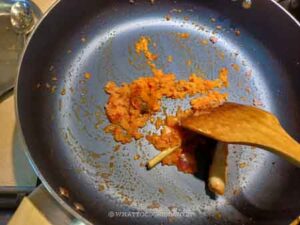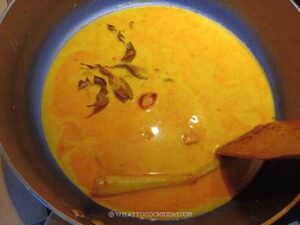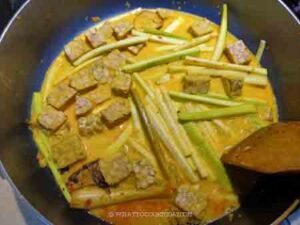This post may contain affiliate links. Please read our disclosure policy.
This Indonesian Chayote and Tempeh Stew (Labu Tempe Lodeh) is a comforting coconut milk–based dish simmered with aromatic spices, chayote (labu siam), and tempeh. It’s creamy, slightly spicy, and full of authentic Indonesian flavors.
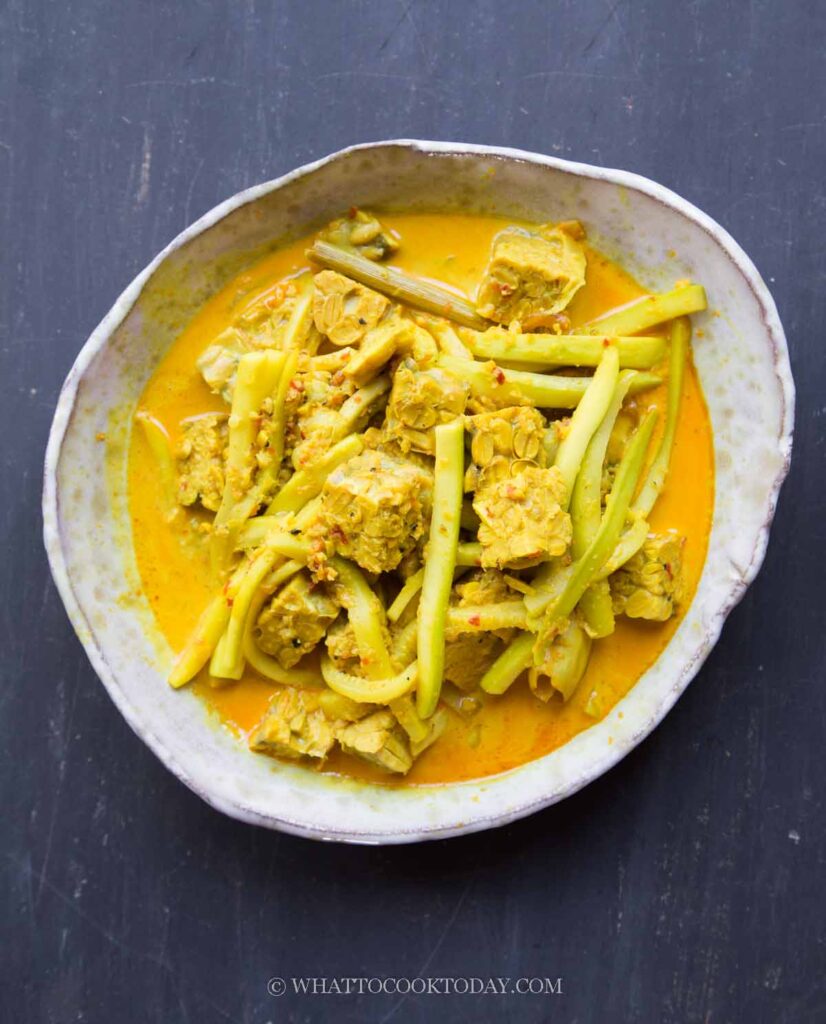
If you’ve ever had sayur lodeh, this comforting Indonesian vegetable stew will feel like home. This version highlights two beloved Indonesian ingredients—labu siam (chayote) and tempeh—simmered in a lightly spiced coconut milk broth that’s rich, aromatic, and slightly tangy. It’s cozy, satisfying, and best served with a warm bowl of rice.
What is Lodeh?
Lodeh is a traditional Indonesian vegetable stew simmered in coconut milk and aromatic spices. The base typically includes a spice paste made from shallots, garlic, shrimp paste, and chili, sautéed until fragrant before being simmered with vegetables and sometimes tofu or tempeh.
Lodeh is very versatile—you can make it vegetarian, add a bit of dried shrimp or anchovies for extra umami, or even add meat. It’s one of those dishes that shows up at family dinners, warung stalls, and festive gatherings across Java. The flavor is rich yet balanced, mildly spicy, and deeply comforting.
What is Chayote (Labu Siam)?
Chayote, known as labu siam in Indonesia, is a type of squash with a mild, crisp texture and slightly sweet flavor. It’s commonly used in Indonesian cooking—especially in soups, stir-fries, and stews like lodeh. When cooked, chayote stays tender-crisp and soaks up all the delicious spices in the broth, making it a perfect match for creamy coconut milk dishes.
Tempeh – A True Indonesian Staple
Tempeh is a fermented soybean cake originating from Indonesia. It’s firm, nutty, and high in protein, making it a great meat alternative. In this stew, the tempeh absorbs the rich coconut and spice flavors, creating a satisfying, hearty texture alongside the chayote.
Why You’ll Like This Recipe
- It’s a homestyle Indonesian dish made with simple ingredients.
- The coconut milk broth is moderately rich, slightly tangy, and bursting with flavor.
- Chayote and tempeh pair beautifully for a satisfying plant-forward meal.
- Perfect for meal prep—flavors get even better the next day!
Ingredients and Substitutions
- Chayote (Labu Siam): A crisp, mild squash that stays slightly crunchy even when cooked. If you can’t find chayote, zucchini makes a great substitute.
- Tempeh: Use firm tofu if you prefer a less dense soy option, but tempeh gives a more authentic Indonesian texture and flavor.
- Dried Shrimp & Shrimp Paste: Add umami depth to the dish. For a vegetarian version, omit them and use a bit of mushroom powder or fermented soybean paste (tauco) instead.
- Coconut Milk: Use canned full-fat coconut milk for richness.
- Tamarind Juice: Adds a subtle tang. You can substitute with lime juice or a small splash of rice vinegar if needed.
- Candlenuts: Provide creaminess and depth. Macadamia nuts are an easy substitute.
- Sambal Oelek: Brings gentle heat. Adjust the amount or replace with chili paste or crushed red pepper for less or more spice.
- Chicken Broth: Can be swapped with vegetable broth to make this dish fully vegetarian.
Tips for Success
- Don’t overcook the chayote. It should stay slightly crisp for the best texture.
- Use good-quality tempeh. Steam it briefly before cooking if you prefer a milder, less bitter taste.
- Keep the heat gentle once you add coconut milk to avoid curdling.
- Make it vegetarian by omitting the dried shrimp and using vegetable broth instead.
How to Store Leftovers
Let the stew cool completely before storing. Transfer to an airtight container and keep it in the refrigerator for up to 3 days. The flavors actually get even better the next day! Reheat gently over medium-low heat on the stove—avoid boiling to prevent the coconut milk from curdling. If you want to freeze it, you can, but note that the texture of the chayote and coconut milk may change slightly once thawed. For best results, enjoy it fresh or within a few days.
Reheating Tips
- Stovetop (best method): Reheat the stew in a saucepan over medium-low heat, stirring occasionally until warmed through. Avoid boiling—it can cause the coconut milk to separate.
- Microwave: Warm in a microwave-safe bowl in short 30-second bursts, stirring in between to heat evenly.
- If the stew thickens after refrigeration, add a splash of water or broth to loosen it up while reheating.
- Taste and adjust seasoning after reheating—sometimes it needs just a pinch of salt or a squeeze of lime to refresh the flavors.
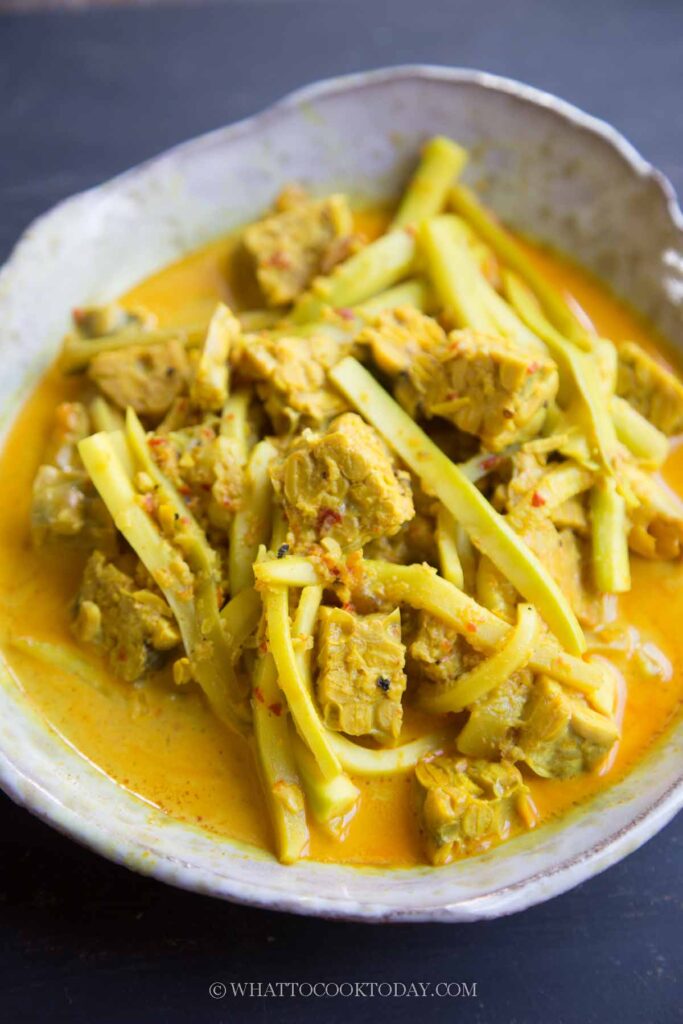
Frequently Asked Questions
1. Can I make this dish vegetarian or vegan?
Yes! Simply skip the dried shrimp and shrimp paste, and use vegetable broth instead of chicken broth.
2. Can I make it ahead?
Absolutely. The flavors develop even more after a day. Store in the fridge for up to 3 days and reheat gently on the stove.
3. Can I freeze it?
You can freeze it, but the texture of the chayote and coconut milk might change slightly after thawing. It’s best enjoyed fresh or within a few days.
4. What can I serve this with?
It’s traditionally served with steamed jasmine rice, but it also pairs nicely with flatbread or rice noodles for a different twist.
5. Can I add other vegetables?
Yes! You can add green beans, cabbage, or carrots—lodeh is very forgiving and customizable.
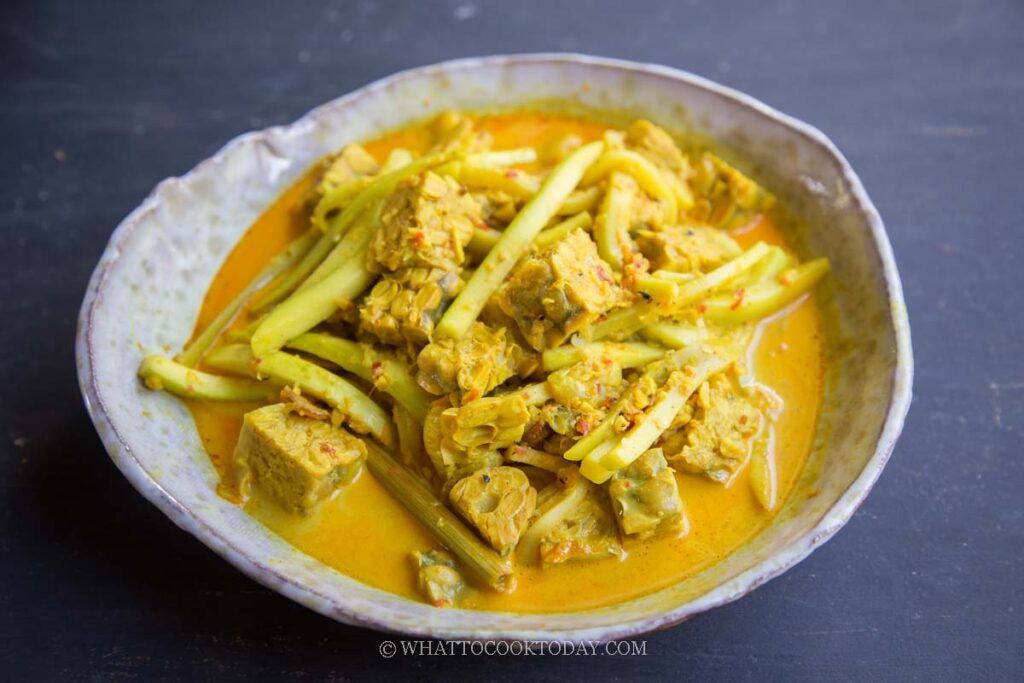
Indonesian Chayote and Tempeh Stew (Labu Tempe Lodeh)
Ingredients
- 1 Tbsp dried shrimp
- 1 stalk lemongrass remove the woody parts on top
- 2 medium chayote peeled and cut into 1/2-inch wide strips
- 227 g tempeh cut into cubes
- 2 Tbsp tamarind juice
- 120 g canned coconut milk
- 120 g chicken broth
- 2 dried bay leaves
Ground spices:
- 5 shallots or use 1 small red onion
- 3 cloves garlic
- ½ tsp shrimp paste
- 3 candlenuts or use macadamia nuts (double the amount)
- 1 Tbsp sambal oelek more if you like it spicier
- ¼ cup oil
Other spices:
- 1 tsp galangal powder
- ½ tsp turmeric powder
- 1 tsp coriander powder
Seasonings:
- ½ tsp sugar
- ¼ tsp Ground white pepper
- Salt to taste
Instructions
Prepare the spice paste:
- Soak the dried shrimp in warm water until soft and set aside
- Place the shallots, garlic, shrimp paste, candlenuts, sambal oelek, the dried shrimp you soaked earlier, and oil in a food processor. Process into a paste.
Start cooking:
- Bruise the lemongrass stalk with a heavy object. Transfer the paste into a large skillet or pot. Add the lemongrass stalk. Turn the heat to medium and start stir frying the spice paste until fragrant, about 2-3 minutes

- Add the chicken broth, coconut milk, tamarind juice, bay leaves, turmeric powder, galangal powder, coriander powder, sugar, white pepper and pinch of salt into the pot.

- Bring to a gentle simmer and then add the chayote and tempeh cubes and let them simmer for about 5 minutes, or until the chayote is tender but not mushy. Don't let the coconut milk boil hard because the coconut milk will curdle

- Have a taste and adjust the seasonings by adding more salt or pepper if needed
To serve:
- Serve with rice or flatbread if you wish
